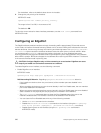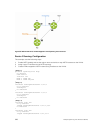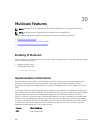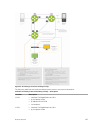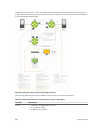
30
Multicast Features
NOTE: Multicast routing is supported on secondary IP addresses; it is not supported on IPv6.
NOTE: Multicast routing is supported across default and non-default VRFs.
The Dell Networking operating system (OS) supports the following multicast protocols:
• PIM Sparse-Mode (PIM-SM)
• Internet Group Management Protocol (IGMP)
• Multicast Source Discovery Protocol (MSDP)
Enabling IP Multicast
Prior to enabling any multicast protocols, you must enable multicast routing. To enable multicast routing,
use the following command.
• Enable multicast routing.
CONFIGURATION mode
ip multicast-routing
Implementation Information
Because protocol control traffic in the Dell Networking OS is redirected using the MAC address, and
multicast control traffic and multicast data traffic might map to the same MAC address, the Dell
Networking OS might forward data traffic with certain MAC addresses to the CPU in addition to control
traffic.
As the upper 5 bits of an IP Multicast address are dropped in the translation, 32 different multicast group
IDs all map to the same Ethernet address. For example, 224.0.0.5 is a known IP address for open shortest
path first (OSPF) that maps to the multicast MAC address 01:00:5e:00:00:05. However, 225.0.0.5,
226.0.0.5, and so on, map to the same multicast MAC address. The Layer 2 forwarding information base
(FIB) alone cannot differentiate multicast control traffic and multicast data traffic with the same address,
so if you use IP address 225.0.0.5 for data traffic, both the multicast data and OSPF control traffic match
the same entry and are forwarded to the CPU. Therefore, do not use well-known protocol multicast
addresses for data transmission, such as the following:
Protocol Ethernet Address
OSPF
01:00:5e:00:00:05
614
Multicast Features



